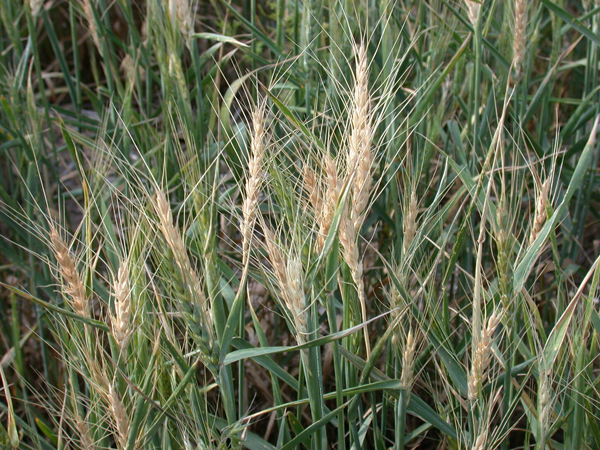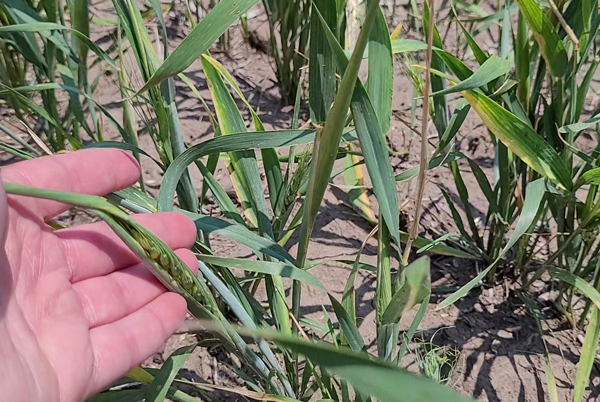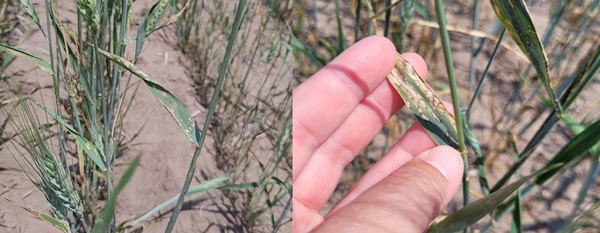Late rains across Kansas have caused some farmers to reconsider the yield potential of portions of their wheat crop. Some wheat is being terminated with herbicides, but neighboring wheat may be headed for harvest. Other farmers are spraying sorghum that has been planted into wheat that has already been terminated. These scenarios set up conditions where herbicide drift could damage the wheat farmers are taking to harvest. This article discusses crop injury caused by some of the herbicides that may be used in these situations.
Glyphosate. Injury resulting from glyphosate drift may appear a few days after application. One common symptom on grasses is a chlorotic band across the leaves that were in the plant's whorl when the drift occurred. If the wheat is heading, just the portion of the plant above the flag leaf may turn white, while the rest of the plant stays green. This may not occur in all tillers as minor differences in the growth stage can influence the symptoms (Figure 1).

Figure 1. White heads caused by glyphosate drift. Photo by Dallas Peterson, K-State Research and Extension.
Atrazine. Atrazine drift on wheat will appear as necrosis where the spray contacts the leaf and may progress to chlorosis/necrosis that starts at the leaf tip and expands down the outer edge of the leaf (Figure 2).

Figure 2. Chlorosis at leaf tips and margins about 2 weeks after a low rate of atrazine was applied. Photo by Sarah Lancaster, K-State Research and Extension.
Group 1 (ACCase-inhibiting) herbicides. These are products such as clethodim (Select Max, others) or quizalofop (Assure II, others). Injury from one of these herbicides will take a week or more to appear. You may see a chlorotic band across the leaves that were in the whorl of the plant. It’s also important to remember that a Group 1 herbicide will have plant-back restrictions for corn or grain sorghum that will vary depending on the product and rate that is used, as well as the hybrids that will be planted. If Co-Axium wheat was planted, quizalofop may cause a limited response (Figure 3).

Figure 3. Wheat head trapped in the boot about two weeks following application of a low rate of Assure II. Also note the chlorosis on the leaves. Photo by Sarah Lancaster, K-State Research and Extension.
Group 14 herbicides. These are products like saflufenacil (Sharpen, Verdict) or flumioxazin (Valor, others). Injury symptoms associated with saflufenacil or flumioxazin will develop within hours of application. They will include water-soaked speckles that become necrotic (Figure 4).

Figure 4. Wheat plants with necrotic speckles caused by simulated Sharpen drift (left) and Valor drift (right). Photos by Sarah Lancaster, K-State Research and Extension.
When terminating failed wheat near a wheat field that will be harvested, there are a few things that can reduce the likelihood of spray drift.
- Monitor wind speed and direction. Choose a time when the wind is blowing within labeled speeds away from the sensitive crop.
- Lower the spray boom. Reducing the distance droplets are suspended in the air will reduce the interaction with wind and the chance for movement.
- Change nozzles. Choose a drift-reduction nozzle with the largest practical nozzle orifice size to create larger droplets.
- Consider a high-quality, label-approved drift reductant. These adjuvants generally increase the viscosity of the spray solution, preventing the formation of smaller droplets.
For more detailed information, see the “2023 Chemical Weed Control for Field Crops, Pastures, and Noncropland” guide available online at https://bookstore.ksre.ksu.edu/pubs/CHEMWEEDGUIDE.pdf or check with your local K-State Research and Extension office for a paper copy.
Additional information about herbicide injury can be found in the KSRE publication C715 “Herbicide Mode of Action” at https://bookstore.ksre.ksu.edu/pubs/C715.pdf.
The use of trade names is for clarity to readers and does not imply endorsement of a particular product, nor does exclusion imply non-approval. Always consult the herbicide label for the most current use requirements.
Sarah Lancaster, Weed Management Specialist
slancaster@ksu.edu
Tags: wheat herbicide drift wind plant injury